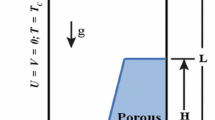Abstract
Unsteady heat transfer in a fluid saturated porous medium contained in a tube is studied. The porous medium is a bed of uniform diameter spheres, made of glass or steel, while the flowing fluid is water. The flow field is time invariant in the simulation as well as experiments. Step response of the bed when the temperature of the incoming water is suddenly increased, and oscillatory response when hot and cold fluids alternately flow through the tube are studied. Heat transfer models are based on thermal equilibrium between the fluid and the solid phase (one-equation) and thermal non-equilibrium (two-equation) between the two phases. The predictions of these models are compared against experiments conducted in a laboratory-scale apparatus. The comparison is in terms of time evolution of temperature profiles at selected points in the bed, as well as global properties of the temperature distribution such as attenuation and phase lag with respect to the boundary perturbations. The range of Peclet numbers considered in the study is 500–4,000, for which the flow can be considered laminar. Results show that the predictions of the two-equation model are uniformly superior to the one-equation model over the range of Peclet numbers studied. The differences among the three approaches diminish when the thermophysical properties of the solid and fluid phases are close to one another. The differences also reduce in the step response test as steady state is approached.


















Similar content being viewed by others
Abbreviations
- A IF :
-
Specific area of the porous insert, m−1
- A f :
-
Non-dimensional value of A IF : A IF × R
- Bi :
-
Biot number, hR/k s
- C p :
-
Specific heat, J (kg K)−1
- d p :
-
Particle diameter, m
- H :
-
Heat transfer coefficient at the particle surface, W m−2 K−1
- K :
-
Thermal conductivity, W (m K)−1
- (k eff,f) z :
-
Effective thermal conductivity of the fluid in z-direction, W (m K)−1
- (k eff,f) z /k f :
-
Dispersion coefficient of fluid in z-direction
- L :
-
Length of porous domain scaled by R
- Nu :
-
Nusselt number, hR/k
- Pe :
-
Peclet number, Re × Pr
- Pr :
-
Prandtl number, μ C p/k
- r :
-
Non-dimensional radial coordinate scaled with R
- R :
-
Characteristic length scale, m also the pipe radius
- Re :
-
Reynolds number, ρ UR/μ
- t :
-
time, non-dimensionalized by αf /R 2
- t p :
-
Time period of oscillation
- T :
-
Non-dimensional temperature: (T− T C)/ΔT
- u :
-
Non-dimensional axial velocity scaled with U
- U :
-
Characteristic fluid velocity equal to the average velocity in the tube, m s−1
- z :
-
Non-dimensional axial distance scaled with R
- α:
-
Thermal diffusivity, cm2 s−1
- β:
-
Thermal capacity ratio between the fluid and the solid
- ΔT :
-
Reference temperature difference: T H − T C (K)
- ɛ:
-
Porosity of the medium
- λ:
-
Thermal conductivity ratio between the fluid and the solid
- μ:
-
Dynamic viscosity of the fluid, kg (m s)−1
- ν:
-
Kinematic viscosity of the fluid, cm2 s−1
- ρ:
-
Material density, kg m−3
- ω:
-
Frequency of oscillations, 2π / t p (rad s−1)
- ϕ:
-
Phase lag, rad
- a:
-
Ambient temperature
- C:
-
Cold water temperature
- H:
-
Hot water temperature
- f:
-
Fluid phase
- m:
-
Porous medium
- s:
-
Solid phase
References
Vafai K, Sozen M (1990) Analysis of the energy and momentum transport for fluid flow through a porous bed. J Heat Transf 112:690–699
Amiri, Vafai K (1994) Analysis of dispersion effects and non-thermal equilibrium, non-Darcian, variable porosity, incompressible flow through porous media. Int J Heat Mass Transf 37:939–954
Peak JW, Kang BH, Hyun JM (1999) Transient cool-down of a porous medium in pulsating flow. Int J Heat Mass Transf 42:3523–3527
Muralidhar K, Suzuki K (2001) Analysis of flow and heat transfer in a regenerator mesh using a non-Darcy thermally non-equilibrium model. Int J Heat Mass Transf 44:2493–2504
Fu HL, Leong KC, Huang XY, Liu CY (2001) An experimental study of heat transfer of a porous channel subjected to oscillating flow. J Heat Transf 123:162–170
Wong WS, Andrew D, Rees S, Pop I (2004) Forced convection past a heated cylinder in a porous medium using a thermal nonequilibrium model: finite Peclet number effects. Int J Therm Sci 43:213–220
Kaviany M (1991) Principles of heat transfer in porous media. Springer, Berlin Heidelberg New York
Nakayama A, Kuwahara F, Sugiyama M (2001) A two energy equation model for conduction and convection in porous media. Int J Heat Mass Transf 44:4375–4379
Wakao N, Kaguei S (1982) Heat and mass transfer in packed beds. Gordon and Breach Science Publishers, New York, p 243
Wakao N, Kaguei S, Funazkri T (1979) Effect of fluid dispersion coefficient on particle-to-fluid heat transfer coefficients in packed beds. Chem Eng Sci 34:325–336
Leonard BP (1979) A stable and accurate convective modeling procedure based on quadratic upstream interpolation. Comput Meth Appl Mech Eng 19:59–98
Author information
Authors and Affiliations
Corresponding author
Rights and permissions
About this article
Cite this article
Singh, C., Tathgir, R.G. & Muralidhar, K. Experimental validation of heat transfer models for flow through a porous medium. Heat Mass Transfer 43, 55–72 (2006). https://doi.org/10.1007/s00231-006-0091-0
Received:
Accepted:
Published:
Issue Date:
DOI: https://doi.org/10.1007/s00231-006-0091-0




